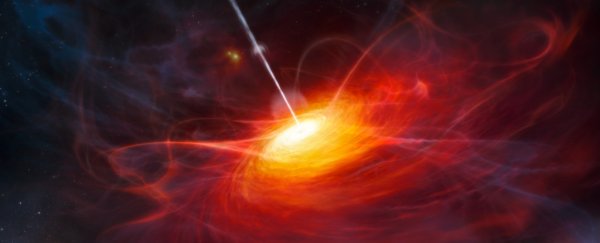One of the largest known black holes in the Universe has turned out to have an appetite to match its prodigious size. New measurements reveal that it's an absolute chonk, clocking in at around 34 billion times the mass of the Sun - and it devours almost one Sun's worth of mass every day.
This makes it the fastest-growing black hole we know of in the entire Universe; its enormity tips it into the category of ultramassive black holes.
"The black hole's mass is also about 8,000 times bigger than the black hole in the centre of the Milky Way," said astronomer Christopher Onken of Australian National University in Australia.
"If the Milky Way's black hole wanted to grow that fat, it would have to swallow two thirds of all the stars in our galaxy."
The discovery of the behemoth in question was first announced in 2018; it powers a blazing quasar in the centre of a galaxy called SMSS J215728.21-360215.1 (J2157 for short) in the early Universe, billions of light-years away.
At time of discovery, astronomers estimated the black hole's mass at around 20 billion solar masses, putting it in the category of ultramassive (over 10 billion solar masses), and its accretion rate - how much material it devours - at half a solar mass a day.
Since then, astronomers have taken new measurements to revise these numbers. And they're mind blowing. At its newly derived mass, the J2157 black hole (J2157*) would have a Schwarzschild radius - the radius of its event horizon - of around 670 astronomical units (AU).
For context, Pluto is, on average, 39.5 astronomical units from the Sun. The heliopause - where the solar wind is no longer strong enough to push against interstellar space - is thought to be over 100 AU from the Sun. Therefore, J2157*'s event horizon is over five times the size of the Solar System.
Those new measurements have revised not just the size and accretion rate of the black hole, but the distance. The adjustment is minuscule given its overall distance from us - just a few tens of millions of light-years. But even such relatively small details matter when it comes to understanding what our Universe was up to when it was barely 1 billion years old.
J2157* is not the heftiest black hole ever discovered. An ultramassive black hole clocking in at around 40 billion solar masses is at the heart of the galaxy Holm 15A, around 700 million light-years away. And then there's the ultramassive black hole powering the quasar TON 618 - an absolute beast at 66 billion solar masses. It's 10.4 billion light-years away.
The black holes of Holm 15A and TON 618 are pretty difficult to understand. We don't know how supermassive or ultramassive black holes form and grow.
But J2157*, hanging around when the Universe was less than 10 percent of its current age, is in a class of its own. Not only do we not know how it formed and grew, we don't know how black holes can grow that massive so soon after the Big Bang.
"It's the biggest black hole that's been weighed in this early period of the Universe," Onken said.
Recent studies, however, have revealed that quasars hosting supermassive black holes didn't just exist in the early Universe - they seem to have been quite common.
This discovery is a huge challenge to our cosmological models, because we know that the formation of such an object should at least take a lot of time, and a lot of matter. So, an ultramassive monster lurking in the early Universe could be another piece of the puzzle.
"With such an enormous black hole, we're also excited to see what we can learn about the galaxy in which it's growing," Onken said.
"Is this galaxy one of the behemoths of the early Universe, or did the black hole just swallow up an extraordinary amount of its surroundings? We'll have to keep digging to figure that out."
The research has been published in the Monthly Notices of the Royal Astronomical Society.
